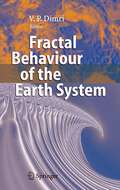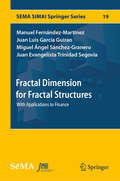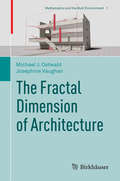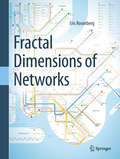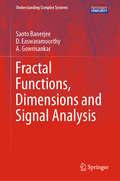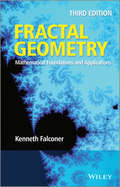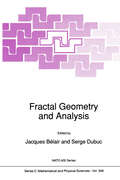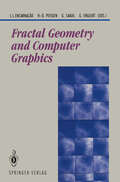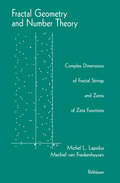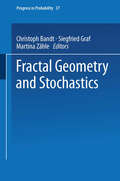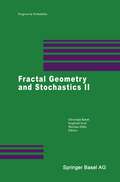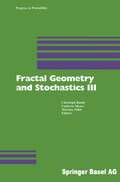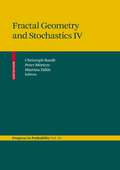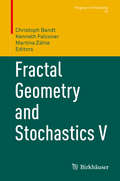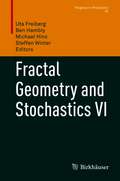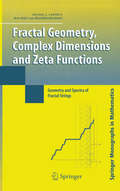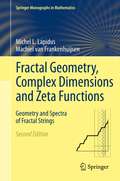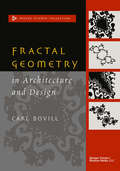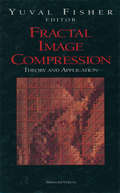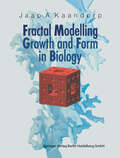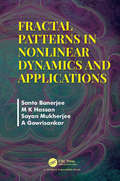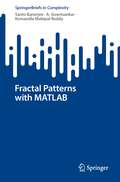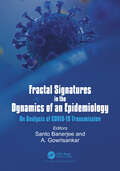- Table View
- List View
Fractal Behaviour of the Earth System
by V. P. DimriIt is with pleasure that I write the foreword to this excellent book. A wide range of observations in geology and solid-earth geophysics can be - plained in terms of fractal distributions. In this volume a collection of - pers considers the fractal behavior of the Earth's continental crust. The book begins with an excellent introductory chapter by the editor Dr. V.P. Dimri. Surface gravity anomalies are known to exhibit power-law spectral behavior under a wide range of conditions and scales. This is self-affine fractal behavior. Explanations of this behavior remain controversial. In chapter 2 V.P. Dimri and R.P. Srivastava model this behavior using Voronoi tessellations. Another approach to understanding the structure of the continental crust is to use electromagnetic induction experiments. Again the results often exhibit power law spectral behavior. In chapter 3 K. Bahr uses a fractal based random resister network model to explain the observations. Other examples of power-law spectral observations come from a wide range of well logs using various logging tools. In chapter 4 M. Fedi, D. Fiore, and M. La Manna utilize multifractal models to explain the behavior of well logs from the main KTB borehole in Germany. In chapter 5 V.V. Surkov and H. Tanaka model the electrokinetic currents that may be as- ciated with seismic electric signals using a fractal porous media. In chapter 6 M. Pervukhina, Y. Kuwahara, and H. Ito use fractal n- works to correlate the elastic and electrical properties of porous media.
Fractal Dimension for Fractal Structures: With Applications to Finance (SEMA SIMAI Springer Series #19)
by Manuel Fernández-Martínez Juan Luis García Guirao Miguel Ángel Sánchez-Granero Juan Evangelista Trinidad SegoviaThis book provides a generalised approach to fractal dimension theory from the standpoint of asymmetric topology by employing the concept of a fractal structure. The fractal dimension is the main invariant of a fractal set, and provides useful information regarding the irregularities it presents when examined at a suitable level of detail. New theoretical models for calculating the fractal dimension of any subset with respect to a fractal structure are posed to generalise both the Hausdorff and box-counting dimensions. Some specific results for self-similar sets are also proved. Unlike classical fractal dimensions, these new models can be used with empirical applications of fractal dimension including non-Euclidean contexts. In addition, the book applies these fractal dimensions to explore long-memory in financial markets. In particular, novel results linking both fractal dimension and the Hurst exponent are provided. As such, the book provides a number of algorithms for properly calculating the self-similarity exponent of a wide range of processes, including (fractional) Brownian motion and Lévy stable processes. The algorithms also make it possible to analyse long-memory in real stocks and international indexes.This book is addressed to those researchers interested in fractal geometry, self-similarity patterns, and computational applications involving fractal dimension and Hurst exponent.
The Fractal Dimension of Architecture (Mathematics and the Built Environment #1)
by Michael J. Ostwald Josephine VaughanFractal analysis is a method for measuring, analysing and comparing the formal or geometric properties of complex objects. In this book it is used to investigate eighty-five buildings that have been designed by some of the twentieth-century’s most respected and celebrated architects. Including designs by Le Corbusier, Eileen Gray, Frank Lloyd Wright, Robert Venturi, Frank Gehry, Peter Eisenman, Richard Meier and Kazuyo Sejima amongst others, this book uses mathematics to analyse arguments and theories about some of the world’s most famous designs. Starting with 625 reconstructed architectural plans and elevations, and including more than 200 specially prepared views of famous buildings, this book presents the results of the largest mathematical study ever undertaken into architectural design and the largest single application of fractal analysis presented in any field. The data derived from this study is used to test three overarching hypotheses about social, stylistic and personal trends in design, along with five celebrated arguments about twentieth-century architecture. Through this process the book offers a unique mathematical insight into the history and theory of design.
Fractal Dimensions of Networks (Springerbriefs In Computer Science Ser.)
by Eric RosenbergCurrent interest in fractal dimensions of networks is the result of more than a century of previous research on dimensions. Fractal Dimensions of Networks ties the theory and methods for computing fractal dimensions of networks to the “classic” theory of dimensions of geometric objects.The goal of the book is to provide a unified treatment of fractal dimensions of sets and networks. Since almost all of the major concepts in fractal dimensions originated in the study of sets, the book achieves this goal by first clearly presenting, with an abundance of examples and illustrations, the theory and algorithms for sets, and then showing how the theory and algorithms have been applied to networks. Thus, the book presents the classical theory and algorithms for the box counting dimension for sets, and then presents the box counting dimension for networks. All the major fractal dimensions are studied, e.g., the correlation dimension, the information dimension, the Hausdorff dimension, the multifractal spectrum, as well as many lesser known dimensions. Algorithm descriptions are accompanied by worked examples, many applications of the methods are presented, and many exercises, ranging in difficulty from easy to research level, are included.
Fractal Functions, Dimensions and Signal Analysis (Understanding Complex Systems)
by Santo Banerjee D. Easwaramoorthy A. GowrisankarThis book introduces the fractal interpolation functions (FIFs) in approximation theory to the readers and the concerned researchers in advanced level. FIFs can be used to precisely reconstruct the naturally occurring functions when compared with the classical interpolants. The book focuses on the construction of fractals in metric space through various iterated function systems. It begins by providing the Mathematical background behind the fractal interpolation functions with its graphical representations and then introduces the fractional integral and fractional derivative on fractal functions in various scenarios. Further, the existence of the fractal interpolation function with the countable iterated function system is demonstrated by taking suitable monotone and bounded sequences. It also covers the dimension of fractal functions and investigates the relationship between the fractal dimension and the fractional order of fractal interpolation functions. Moreover, this book explores the idea of fractal interpolation in the reconstruction scheme of illustrative waveforms and discusses the problems of identification of the characterizing parameters. In the application section, this research compendium addresses the signal processing and its Mathematical methodologies. A wavelet-based denoising method for the recovery of electroencephalogram (EEG) signals contaminated by nonstationary noises is presented, and the author investigates the recognition of healthy, epileptic EEG and cardiac ECG signals using multifractal measures. This book is intended for professionals in the field of Mathematics, Physics and Computer Science, helping them broaden their understanding of fractal functions and dimensions, while also providing the illustrative experimental applications for researchers in biomedicine and neuroscience.
Fractal Geometry: Mathematical Foundations and Applications
by Kenneth FalconerThe seminal text on fractal geometry for students and researchers: extensively revised and updated with new material, notes and references that reflect recent directions. Interest in fractal geometry continues to grow rapidly, both as a subject that is fascinating in its own right and as a concept that is central to many areas of mathematics, science and scientific research. Since its initial publication in 1990 Fractal Geometry: Mathematical Foundations and Applications has become a seminal text on the mathematics of fractals. The book introduces and develops the general theory and applications of fractals in a way that is accessible to students and researchers from a wide range of disciplines. Fractal Geometry: Mathematical Foundations and Applications is an excellent course book for undergraduate and graduate students studying fractal geometry, with suggestions for material appropriate for a first course indicated. The book also provides an invaluable foundation and reference for researchers who encounter fractals not only in mathematics but also in other areas across physics, engineering and the applied sciences. Provides a comprehensive and accessible introduction to the mathematical theory and applications of fractals Carefully explains each topic using illustrative examples and diagrams Includes the necessary mathematical background material, along with notes and references to enable the reader to pursue individual topics Features a wide range of exercises, enabling readers to consolidate their understanding Supported by a website with solutions to exercises and additional material http://www.wileyeurope.com/fractal Leads onto the more advanced sequel Techniques in Fractal Geometry (also by Kenneth Falconer and available from Wiley)
Fractal Geometry: Mathematical Foundations and Applications (Progress In Probability Ser. #70)
by Kenneth FalconerThe seminal text on fractal geometry for students and researchers: extensively revised and updated with new material, notes and references that reflect recent directions. Interest in fractal geometry continues to grow rapidly, both as a subject that is fascinating in its own right and as a concept that is central to many areas of mathematics, science and scientific research. Since its initial publication in 1990 Fractal Geometry: Mathematical Foundations and Applications has become a seminal text on the mathematics of fractals. The book introduces and develops the general theory and applications of fractals in a way that is accessible to students and researchers from a wide range of disciplines. Fractal Geometry: Mathematical Foundations and Applications is an excellent course book for undergraduate and graduate students studying fractal geometry, with suggestions for material appropriate for a first course indicated. The book also provides an invaluable foundation and reference for researchers who encounter fractals not only in mathematics but also in other areas across physics, engineering and the applied sciences. Provides a comprehensive and accessible introduction to the mathematical theory and applications of fractals Carefully explains each topic using illustrative examples and diagrams Includes the necessary mathematical background material, along with notes and references to enable the reader to pursue individual topics Features a wide range of exercises, enabling readers to consolidate their understanding Supported by a website with solutions to exercises and additional material http://www.wileyeurope.com/fractal Leads onto the more advanced sequel Techniques in Fractal Geometry (also by Kenneth Falconer and available from Wiley)
Fractal Geometry and Analysis (Nato Science Series C: #346)
by Jacques Bélair Serge DubucThis ASI- which was also the 28th session of the Seminaire de mathematiques superieures of the Universite de Montreal - was devoted to Fractal Geometry and Analysis. The present volume is the fruit of the work of this Advanced Study Institute. We were fortunate to have with us Prof. Benoit Mandelbrot - the creator of numerous concepts in Fractal Geometry - who gave a series of lectures on multifractals, iteration of analytic functions, and various kinds of fractal stochastic processes. Different foundational contributions for Fractal Geometry like measure theory, dy namical systems, iteration theory, branching processes are recognized. The geometry of fractal sets and the analytical tools used to investigate them provide a unifying theme of this book. The main topics that are covered are then as follows. Dimension Theory. Many definitions of fractional dimension have been proposed, all of which coincide on "regular" objects, but often take different values for a given fractal set. There is ample discussion on piecewise estimates yielding actual values for the most common dimensions (Hausdorff, box-counting and packing dimensions). The dimension theory is mainly discussed by Mendes-France, Bedford, Falconer, Tricot and Rata. Construction of fractal sets. Scale in variance is a fundamental property of fractal sets.
Fractal Geometry and Computer Graphics (Beiträge zur Graphischen Datenverarbeitung)
by Jose L. Encarnacao Heinz-Otto Peitgen Georgios Sakas Gabriele EnglertFractal geometry has become popular in the last 15 years, its applications can be found in technology, science, or even arts. Fractal methods and formalism are seen today as a general, abstract, but nevertheless practical instrument for the description of nature in a wide sense. But it was Computer Graphics which made possible the increasing popularity of fractals several years ago, and long after their mathematical formulation. The two disciplines are tightly linked. The book contains the scientificcontributions presented in an international workshop in the "Computer Graphics Center" in Darmstadt, Germany. The target of the workshop was to present the wide spectrum of interrelationships and interactions between Fractal Geometry and Computer Graphics. The topics vary from fundamentals and new theoretical results to various applications and systems development. All contributions are original, unpublished papers.The presentations have been discussed in two working groups; the discussion results, together with actual trends and topics of future research, are reported in the last section. The topics of the book are divides into four sections: Fundamentals, Computer Graphics and Optical Simulation, Simulation of Natural Phenomena, Image Processing and Image Analysis.
Fractal Geometry and Number Theory: Complex Dimensions of Fractal Strings and Zeros of Zeta Functions (Proceedings Of Symposia In Applied Mathematics Ser.)
by Michel L. Lapidus Machiel van FrankenhuysenFractal Geometry and Stochastics (Progress in Probability #37)
by Christoph Bandt Siegfried Graf Martina ZähleFractal geometry is a new and promising field for researchers from different disciplines such as mathematics, physics, chemistry, biology and medicine. It is used to model complicated natural and technical phenomena. The most convincing models contain an element of randomness so that the combination of fractal geometry and stochastics arises in between these two fields. It contains contributions by outstanding mathematicians and is meant to highlight the principal directions of research in the area. The contributors were the main speakers attending the conference "Fractal Geometry and Stochastics" held at Finsterbergen, Germany, in June 1994. This was the first international conference ever to be held on the topic. The book is addressed to mathematicians and other scientists who are interested in the mathematical theory concerning: • Fractal sets and measures • Iterated function systems • Random fractals • Fractals and dynamical systems, and • Harmonic analysis on fractals. The reader will be introduced to the most recent results in these subjects. Researchers and graduate students alike will benefit from the clear expositions.
Fractal Geometry and Stochastics II (Progress in Probability #46)
by Christoph Bandt Siegfried Graf Martina ZähleA collection of contributions by outstanding mathematicians, highlighting the principal directions of research on the combination of fractal geometry and stochastic methods. Clear expositions introduce the most recent results and problems on these subjects and give an overview of their historical development.
Fractal Geometry and Stochastics III (Progress in Probability #57)
by Christoph Bandt Umberto Mosco Martina ZähleThis up-to-date monograph, providing an up-to-date overview of the field of Hepatitis Prevention and Treatment, includes contributions from internationally recognized experts on viral hepatitis, and covers the current state of knowledge and practice regarding the molecular biology, immunology, biochemistry, pharmacology and clinical aspects of chronic HBV and HCV infection. The book provides the latest information, with sufficient background and discussion of the literature to benefit the newcomer to the field.
Fractal Geometry and Stochastics IV (Progress in Probability #61)
by Christoph Bandt Peter Mörters Martina ZähleOver the last fifteen years fractal geometry has established itself as a substantial mathematical theory in its own right. The interplay between fractal geometry, analysis and stochastics has highly influenced recent developments in mathematical modeling of complicated structures. This process has been forced by problems in these areas related to applications in statistical physics, biomathematics and finance. This book is a collection of survey articles covering many of the most recent developments, like Schramm-Loewner evolution, fractal scaling limits, exceptional sets for percolation, and heat kernels on fractals. The authors were the keynote speakers at the conference "Fractal Geometry and Stochastics IV" at Greifswald in September 2008.
Fractal Geometry and Stochastics V (Progress in Probability #70)
by Christoph Bandt Kenneth Falconer Martina ZähleThis book collects significant contributions from the fifth conference on Fractal Geometry and Stochastics held in Tabarz, Germany, in March 2014. The book is divided into five topical sections: geometric measure theory, self-similar fractals and recurrent structures, analysis and algebra on fractals, multifractal theory, and random constructions. Each part starts with a state-of-the-art survey followed by papers covering a specific aspect of the topic. The authors are leading world experts and present their topics comprehensibly and attractively. Both newcomers and specialists in the field will benefit from this book.
Fractal Geometry and Stochastics VI (Progress in Probability #76)
by Uta Freiberg Ben Hambly Michael Hinz Steffen WinterThis collection of contributions originates from the well-established conference series "Fractal Geometry and Stochastics" which brings together researchers from different fields using concepts and methods from fractal geometry.Carefully selected papers from keynote and invited speakers are included, both discussing exciting new trends and results and giving a gentle introduction to some recent developments. The topics covered include Assouad dimensions and their connection to analysis, multifractal properties of functions and measures, renewal theorems in dynamics, dimensions and topology of random discrete structures, self-similar trees, p-hyperbolicity, phase transitions from continuous to discrete scale invariance, scaling limits of stochastic processes, stemi-stable distributions and fractional differential equations, and diffusion limited aggregation.Representing a rich source of ideas and a good starting point for more advanced topics in fractal geometry, the volume will appeal to both established experts and newcomers.
Fractal Geometry, Complex Dimensions and Zeta Functions: Geometry and Spectra of Fractal Strings (Springer Monographs in Mathematics)
by Michel L. Lapidus Machiel van FrankenhuijsenNumber theory, spectral geometry, and fractal geometry are interlinked in this study of the vibrations of fractal strings, that is, one-dimensional drums with fractal boundary. The Riemann hypothesis is given a natural geometric reformulation in context of vibrating fractal strings, and the book offers explicit formulas extended to apply to the geometric, spectral and dynamic zeta functions associated with a fractal.
Fractal Geometry, Complex Dimensions and Zeta Functions: Geometry and Spectra of Fractal Strings (Springer Monographs in Mathematics)
by Michel L. Lapidus Machiel van FrankenhuijsenNumber theory, spectral geometry, and fractal geometry are interlinked in this in-depth study of the vibrations of fractal strings, that is, one-dimensional drums with fractal boundary.Throughout Geometry, Complex Dimensions and Zeta Functions, Second Edition, new results are examined and a new definition of fractality as the presence of nonreal complex dimensions with positive real parts is presented. The new final chapter discusses several new topics and results obtained since the publication of the first edition.
Fractal Geometry in Architecture and Design (Design Science Collection)
by Carl Bovillna broad sense Design Science is the grammar of a language of images Irather than of words. Modern communication techniques enable us to transmit and reconstitute images without needing to know a specific verbal sequence language such as the Morse code or Hungarian. International traffic signs use international image symbols which are not specific to any particular verbal language. An image language differs from a verbal one in that the latter uses a linear string of symbols, whereas the former is multi dimensional. Architectural renderings commonly show projections onto three mutual ly perpendicular planes, or consist of cross sections at different altitudes capa ble of being stacked and representing different floor plans. Such renderings make it difficult to imagine buildings comprising ramps and other features which disguise the separation between floors, and consequently limit the cre ative process of the architect. Analogously, we tend to analyze natural struc tures as if nature had used similar stacked renderings, rather than, for instance, a system of packed spheres, with the result that we fail to perceive the system of organization determining the form of such structures. Perception is a complex process. Our senses record; they are analogous to audio or video devices. We cannot, however, claim that such devices perceive.
Fractal Image Compression: Theory and Application
by Yuval FisherOne half of the book is authored by Yuval Fisher himself, while articles from another 12 experts in the field present material from different points of view. The focus here is solely on fractal image encoding, with the aim of providing a working code that is usable in applications, while containing the complete details of how to encode and decode images. An indispensable "how to" guide, combining the very latest results in the field. Of interest to a very wide audience, ranging from experts in image processing to high school students.
Fractal Modelling: Growth and Form in Biology
by Jaap A. KaandorpIn this book, methods from fractal geometry are applied to model growth forms, taking as a case study a type of growth process which can be found among various taxonomic classes such as sponges and corals. These models can be used, for example, to understand the amazing variety of forms to be found in a coral reef and to simulate their growth with 2D and 3D geometrical objects. Models which mimic the growth of forms and the environmental influence on the growth process are also useful for ecologists, as a combination of simulation models together with the actual growth forms can be used to detect the effects of slow changes in the environment.
Fractal Patterns in Nonlinear Dynamics and Applications: Patterns in Nonlinear Dynamics and Applications
by Santo Banerjee M K Hassan Sayan Mukherjee A GowrisankarMost books on fractals focus on deterministic fractals as the impact of incorporating randomness and time is almost absent. Further, most review fractals without explaining what scaling and self-similarity means. This book introduces the idea of scaling, self-similarity, scale-invariance and their role in the dimensional analysis. For the first time, fractals emphasizing mostly on stochastic fractal, and multifractals which evolves with time instead of scale-free self-similarity, are discussed. Moreover, it looks at power laws and dynamic scaling laws in some detail and provides an overview of modern statistical tools for calculating fractal dimension and multifractal spectrum.
Fractal Patterns in Nonlinear Dynamics and Applications: Patterns in Nonlinear Dynamics and Applications
by Santo Banerjee M K Hassan Sayan Mukherjee A GowrisankarMost books on fractals focus on deterministic fractals as the impact of incorporating randomness and time is almost absent. Further, most review fractals without explaining what scaling and self-similarity means. This book introduces the idea of scaling, self-similarity, scale-invariance and their role in the dimensional analysis. For the first time, fractals emphasizing mostly on stochastic fractal, and multifractals which evolves with time instead of scale-free self-similarity, are discussed. Moreover, it looks at power laws and dynamic scaling laws in some detail and provides an overview of modern statistical tools for calculating fractal dimension and multifractal spectrum.
Fractal Patterns with MATLAB (SpringerBriefs in Complexity)
by Santo Banerjee A. Gowrisankar Komandla Mahipal ReddyThis book presents the iterative beauty of fractals and fractal functions graphically with the aid of MATLAB programming. The fractal images generated using the MATLAB codes provide visual delight and highly encourage the fractal lovers for creative thinking. The book compiles five cutting-edge research chapters, each with state-of-the art fractal illustrations. It starts with the fundamental theory for the construction of fractal sets via the deterministic iteration algorithm. Incorporating the theoretical base, fractal illustrations of elementary fractal sets are provided with the explicit MATLAB code. The book gives examples of MATLAB codes to present the fractal surfaces. This book is contributed to all the research beginners as well as the professionals on the field of fractal analysis. As it covers basic fractals like Sierpinski triangle to advanced fractal functions with explicit MATLAB code, the presented fractal illustrations hopefully benefit even the non-field readers. The book is a useful course to all the research beginners on the fractal and fractal-related fields.
Fractal Signatures in the Dynamics of an Epidemiology: An Analysis of COVID-19 Transmission
by Santo Banerjee A. GowrisankarThe recent Covid-19 pandemic threw the world into complete chaos with its rapid and devastating spread. Scientists are still trying to obtain a better understanding of the patterns of COVID-19 and trying to get a deeper understanding of mutant strains and their pathogenicity by performing genomic sequences of more samples. Fractal-based analysis provides its unique forecasting policy to reduce the spread of COVID-19, and in general, of any outbreaks. The book presents fractal and multifractal models of COVID-19 and reviews the impact of the pandemic including epidemiology, genome organization, transmission cycle, and control strategies based on mathematical models towards developing an immune intervention. Also, it covers non-clinical aspects such as economic development with graphical illustrations, meeting the needs of onlookers outside the sector who desire additional information on the epidemic. The fractal signatures describe the fractal textures in the patterns of Corona virus. Studies on the epidemiology of Covid-19 in relation with the fractals and fractal functions serve to exhibit its irregular chaotic nature. Moreover, the book with its wide coverage on the Hurst exponent analysis and the fractal dimension estimation, greatly aids in measuring the epidemiology.
